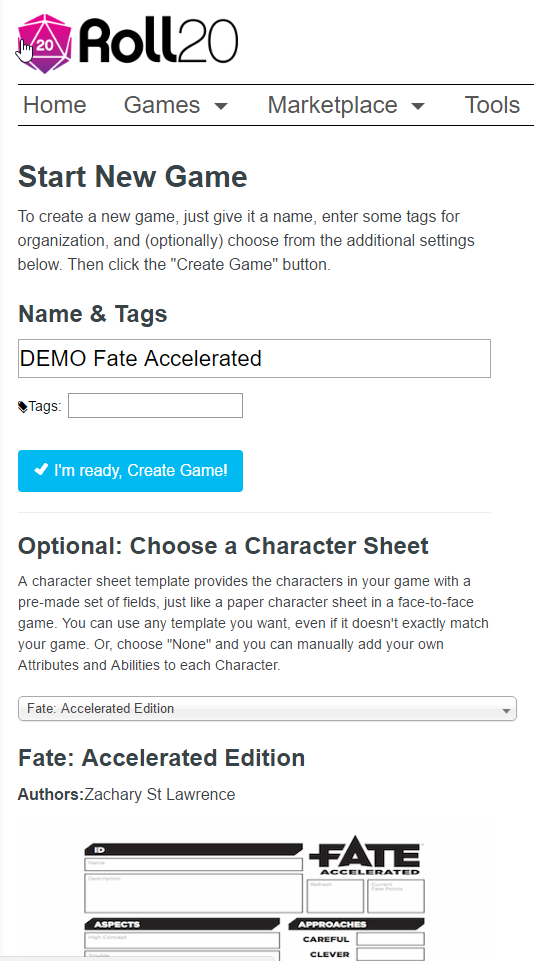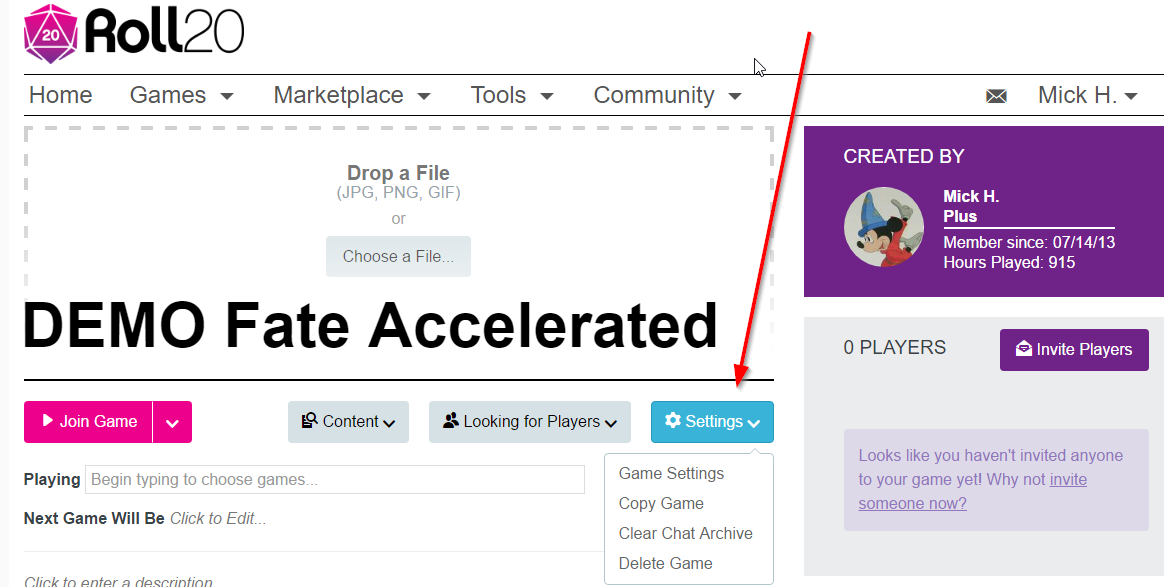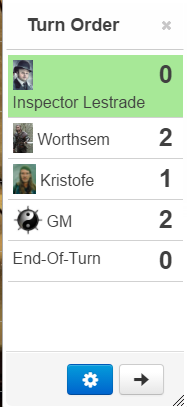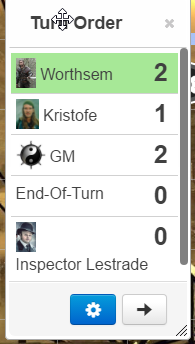Running Fate Accelerated on Roll20
From Roll20 Wiki
WORK IN PROGRESS - need to work out how to format the macros to avoid getting spaces in the follow-on lines
Tips for creating and running Fate Accelerated games on Roll20
To find out something about my Role Playing Experience and get some generic DM Tips, please take a look at Mick Hand's GM Tips
Although this seems like a large set of recommendations,
| DON'T PANIC |
You don’t have to spend hours on end preparing each game session.
Realistically, you should probably expect to spend an hour or two preparing your first one and then less than an 1 hour technical prep for a 4-hr game session. You should do a bit of practice with the Maps, Dice rolling and Tokens before you start playing the game for real. It should be a lot less technical effort to set up and run games using Fate Accelerated than for crunchier games.
Creating the Campaign
From the “Start New Game” option…
Enter the name for your Campaign Choose the Character Sheet called “Dresden Files Accelerated” Click “I’m Ready, Create Game”
As soon as you have clicked “I’m Ready, Create Game”, you will Join the Game as the GM. You are taken to an empty page. Before you do anything else, it is worth exiting the game and then going to the “Game Settings” page to set up a couple of default settings.
Click the Cog Icon on the far right to get to the “My Settings” section Click the “Exit Game” button at the top of the “My Settings” section.
This takes you to the “Thank you for playing….” Screen. There’s no need to fill anything in there yet, so just hover over “Games” to see a list of your recent games and click on the image for the one you just created (in my case this was “Demo Fate Accelerated”)
From the main Game page, choose the “Settings” option and then choose “Game Settings”…
The Game Settings page doesn’t have much on it for a FATE game, but here are my recommendations for a Fate Accelerated game.
This page works a bit strangely, so my advice is to Expand the “Game Default Settings” by clicking on it and this opens up a lot more defaults…
Some people like to set the “Page DefaultsBackground” to some pale colour other than white, as bright white screens are meant to be bad for our eyes. In the Player Permissions… Name = Tick the “See” option Bar 1 = Tick the “See” option CLICK “Save Defaults”
After it saves the “Game Default Settings” it will close that section.
Click “Save Changes” at the bottom of the screen.
Now you are ready to “Join the Game” again. This time, head to the Cog Icon and set a few things in the “My Settings” section. These settings will be remembered next time you Join the Game so you shouldn’t have to change them again.
I very much recommend ticking the “Use advanced keyboard shortcuts”.
I recommend not ticking the “Use window popouts for characters”. This is purely because of Macros that ask you to choose or fill-in something. If you use Window Popouts, then the focus isn’t on the main Roll20 Window and the dialog will appear behind the character sheet and won’t automatically have focus so you can just hit return.
I recommend not ticking the Enable Advanced Dice.
I recommend not ticking the Enable 3D Dice. There don’t seem to be any animated Fudge Dice.
I recommend not ticking the Automatically roll 3D Dice.
The Basics of Roll20 for Fate Accelerated
There is no Compendium of monsters already set up for Fate Accelerated (as there is for D&D5E and Pathfinder).
There is little use for the Grid as combat and movement are much more narrative than for games like D&D.
My recommendations are…
Set up some Journal Entries with default Tokens to use as Aspects, Boosts, Conditions Using Status Markers with numbers to indicate how many free-invokes are available on Boosts Use green blob for free invokes available to Players Use red blob for free invokes available to the GM characters Use background images to set the scene Use Handouts to show images to Players (or Shift-Z to show an image of a Token) Use the Turn Order to track Player and GM Fate Points Also use the Turn Order to track who goes next Set up some macros… for Players to get them to use the 4 Action Types (Overcome, Create Advantage, Attack, Defend) for Players to spend a Fate Point for a +2 Bonus for Players to spend a Fate Point for a Re-roll for Players to indicate they are taking a Boost or Free Invoke for the GM to use the 4 Action Types for non-player characters for the GM to give a player character a Fate Point for the GM to indicate the use of Scale as either +1 to a Roll or +2 to an effect (Scale is a feature from Dresden Files Accelerated)
The MACROS
The Macros I’m suggesting should make your FATE games run more smoothly.
It may seem odd to use the Turn Order as a way to track Fate Points, but without the API capabilities, the Turn Order is just about the only thing that a macro can make changes to. So we can write macros to add or subtract from the Turn Order, making it easy to keep track of Fate Points. It also keeps the current Fate Point scores in plain view.
The four Macros whose names start with “Action-” help to focus the players’ minds into the four types of Action. Particularly with new Fate players, it helps them to understand how to phrase their intentions to avoid the uncertain or ambiguous narrative action conversations such as...
Player “I want to shoot him in the leg”
GM “Are you intending to do him damage?”
Player “Yes, and it will slow him down and distract him with the pain as well and might force him to surrender”
GM “You’ll have to pick whether it’s an ATTACK to do damage or it’s a CREATE-ADVANTAGE to give him an aspect of limping or an OVERCOME to terrify him into surrendering”
Once the Player has selected which type of Action they are doing, they get to type a brief narrative tag for it and then choose which of their Approaches they want to use.
The result of the actual Dice Roll is shown in the chat window along with Approach and the bonus from the Approach. It’s easier to see what the actual Roll is, to help the player decide whether it would be better to spend a Fate Point to re-roll or add +2.
The following Macros should be flagged as “Token Action” and made visible to ALL PLAYERS…
Action-ATTACK
&{template:default} Template:Name=ATTACK {{character=@{selected|token_name}}} {{Intention=?{Intention|Attack...}}} {{Roll=4dF}}{{Approach=?{Approach|Flashy,FLASHY +
@{selected|flashy}|Careful,CAREFUL + @{selected|careful}|Forceful,FORCEFUL + @{selected|forceful}|Sneaky,SNEAKY + @{selected|sneaky}|Quick,QUICK +
@{selected|quick}|Clever,CLEVER + @{selected|clever}}}}
Action-CREATE-ADVANTAGE
&{template:default} Template:Name=CREATE ADVANTAGE {{character=@{selected|token_name}}}{{Intention=?{Intention|Create Advantage...}}} {{Roll=4dF}}{{Approach=?
{Approach|Flashy,FLASHY + @{selected|flashy}|Careful,CAREFUL + @{selected|careful}|Forceful,FORCEFUL + @{selected|forceful}|Sneaky,SNEAKY +
@{selected|sneaky}|Quick,QUICK + @{selected|quick}|Clever,CLEVER + @{selected|clever}}}}
Action-DEFEND
&{template:default} Template:Name=DEFEND {{character=@{selected|token_name}}} {{Intention=?{Intention|Defend...}}} {{Roll=4dF}}{{Approach=?{Approach|Flashy,FLASHY +
@{selected|flashy}|Careful,CAREFUL + @{selected|careful}|Forceful,FORCEFUL + @{selected|forceful}|Sneaky,SNEAKY + @{selected|sneaky}|Quick,QUICK +
@{selected|quick}|Clever,CLEVER + @{selected|clever}}}} &{template:default}
Action-OVERCOME
Template:Name=OVERCOME {{character=@{selected|token_name}}} {{Intention=?{Intention|Overcome...}}} {{Roll=4dF}}{{Approach=?{Approach|Flashy,FLASHY + @{selected|flashy}|Careful,CAREFUL + @{selected|careful}|Forceful,FORCEFUL + @{selected|forceful}|Sneaky,SNEAKY + @{selected|sneaky}|Quick,QUICK + @{selected|quick}|Clever,CLEVER + @{selected|clever}}}}
Fate+2
&{template:default} Template:Name=Fate+2{{character=@{selected|token_name}}}{{Because=?{Because...}}}{{Fate=Point Spent [[1d1 &{tracker:-}]]
Fate-REROLL
&{template:default} Template:Name=FATE REROLL{{character=@{selected|token_name}}}{{Because=?{Because...}}}{{Roll=4dF}} {{Fate=Point Spent [[1d1 &{tracker:-}]]
Free-Invoke+2
&{template:default} Template:Name=Free Invoke+2{{character=@{selected|token_name}}}{{Because=?{Because...}}}
Free-Invoke-REROLL
&{template:default} Template:Name=Free Invoke REROLL{{character=@{selected|token_name}}}{{Because=?{Because...}}}
The Player Macros appear at the top of the screen when they have selected their Token…
The following Macros should be flagged as “In Bar” and are only visible to the GM.
I usually right-click on the buttons in the GM’s Bar (at the bottom of the main page) and then make them bright red.
FATE-POINT-GIVE
&{template:default} Template:Name=FATE POINT GRANTED {{character=@{selected|token_name}}}{{Because=?{Because...}}} {{Fate=Point Granted [[1d1 &{tracker:+}]]
FATE-POINT-TAKE
&{template:default} Template:Name=FATE POINT TAKEN{{character=@{selected|token_name}}}{{Because=?{Because...}}} {{Fate=Point Taken [[1d1 &{tracker:-}]]
NPC-ACTION
&{template:default} Template:Name=NPC ACTION {{character=@{selected|token_name}}} {{NPC Action=?{NPC Action|ATTACK|DEFEND|CREATE ADVANTAGE|OVERCOME}}} {{Intention=?
{Intention}}} {{Roll=4dF}} {{Approach Bonus=?{Approach|+4,+4|+3,+3|+2,+2|+1,+1|0,0|-1,-1|-2,-2}}}
Scale-Effect+2
&{template:default} Template:Name=SCALE Bonus +2 to EFFECT{{character=@{selected|token_name}}}{{Because=?{Because...}}}
Scale-Roll+1
&{template:default} Template:Name=SCALE Bonus +1 to roll{{character=@{selected|token_name}}}{{Because=?{Because...}}}
The GM Macros appear at the bottom of the screen…
Initiative for Fate Accelerated
Because I propose using the Turn Order to keep track of Fate Points, it should always be open.
Put all the Player Characters into the Tracker at the start of the game and leave it open.
Add in tokens for the Monsters (or just a single token for the GM if you want to have all the GM creatures go at the same time).
Set the GM’s Score in the Turn Order to the number of Player Characters involved in the scene.
Click the Cog and “Add Custom Item” and add an “End-Of-Turn“ marker.
| I'm using a small variation on the FAE rules for initiative, where the order of turns is determined by choice - it's from Dresden files Accelerated (and from Fate Core) |
The GM decides who should go first (taking into account the situation and the Quick score of the Player Characters and the monsters).
Almost always have one of the Players going first (unless they have been ambushed!)
In the example above, Lestrade is going first (the poor chap is out of Fate Points).
When a Player Character has finished their go, drag the Player to below the End-Of-Turn marker.
The person who finishes their go, chooses who goes next from the ones still above the End-Of-Turn marker.
Beware leaving the GM to go last as the person who goes last decides who goes first in the next Turn, so can give themselves two consecutive goes if they want to.
After Lestrade has had his go, he is dragged down to after the End-Of-Turn..
At the end of each Turn, drag the End-Of-Turn marker to the bottom of the Turn Order.
Setting up a character for a Player Character
Player Characters are created in the Journal by clicking the “+Add” button and then selecting “Character”.
This opens a Creature dialog box with a random name.
I usually type the name of the Player in there unless I already know the name of their character.
Set the “In Player’s Journals” to “All Players”
If your players have already joined the game, you can set the “Can Be Edited & Controlled By” to be the specific Player, otherwise leave this blank until they have joined. They can join and exit at times when you are not connected and as long as they have joined at least once, you can grant them control by changing the “Can Be Edited & Controlled By”.
Click “Save Changes”
Assigning the PC to a Token
Add the token to the Map
Associate the Token by selecting it, clicking its Cog and setting the “Represents Character” option.
Save Changes.
Make that token the Default Token for the PC by associating it with the Character in the Journal.
Creating Handouts in the Journal
How to create them – just click the “+Add” button in the Journal tab, and choose Handout.
What can you use them for?
Rules explanations. Notes – such as Party Treasure list – assign control to a trusted Player Pictures of things you might want to show Treasure Maps The Map of the Campaign area Riddles Info about organisations, areas or people.
You can make handouts visible to ALL PLAYERS or to just one or two.
Adding your own Art to the Art Library
I usually save images into a folder on my own machine ready to drag into Roll20.
It’s best to save the images in as low-resolution as possible (but still keeping enough definition to not look too tatty). This will use up less of your storage space and (more importantly) load quicker and use less memory while playing in Roll20.
The Map Layer – using a Map Image
You can Drag an image direct from your own PC onto the Map Layer or you can drag a picture out of the Art Library tab.
The Map Layer – drawing your own map
If you have some map tile images in your Art Library you can drop them onto the Map Layer to make your own maps. You can also draw rough sketch maps on the map layer just using the drawing tools. For Fate Accelerated maps for combat situations are rarely needed - sometimes a sketch of Zones is all you need.
The GM Layer – Only YOU can see the things on this layer
Use it to place monster/npc tokens ready for use and only move them to the Objects layer when they become visible to the player characters.
Tokens that are on the GM Layer can still be added to the Turn Order (but only YOU will see them)
Use the GM Layer for INVISIBLE (or hidden) monster/npc tokens.
Use it to place notes for yourself (reminders about Traps or Secret Doors or Treasure or room numbers etc)
The Object Layer
This is where PC tokens belong and where any visible objects should be if you intend to interact with them during the game (move them, change names, put status effect icons on them).
Showing things to Players
Shift+Z on a selected token to show a bigger picture of the token to all players
When you edit a Handout from the Journal you can “Show to Players”
You can paste links to external pictures (pinterest or google images) into the chat
Useful Keyboard shortcuts
s = switch to the Select mode (this is one of the most useful to switch back from Drawing Mode or Measuring mode)
o = switch to the Objects Layer, with selected objects Shift+Ctrl+o moves them to the Objects Layer and switches you to the Objects Layer
m = switch to the Map Layer, with selected objects Shift+Ctrl+m moves them to the Map Layer and switches you to the Map Layer
k = switch to the GM Layer, with selected objects Shift+Ctrl+k moves them to the GM Layer and switches you to the GM Layer
i = show the Art tab in the sidebar
q = switch to the Ruler mode
Shift+Z to show the selected token to all players
Ctrl+L to see what a Token can see (based on Dynamic Lighting)
Arrow keys to move selected tokens a square at a time.
Hitting Space after a move to show the distance moved
c c to jump to the Chat Tab and put focus into the chat entry box ready to type something
c c shift-tab = to the bottom of the Chat if you are on a different side-bar tab and then force the chat to scroll to the end.














